 W
WAdhesive, also known as glue, cement, mucilage, or paste, is any non-metallic substance applied to one or both surfaces of two separate items that binds them together and resists their separation.
 W
WAnimal glue is an organic colloid of protein derivation used as an adhesive, sizing and coating, compo, and for colloidal applications in industry which is derived primarily from collagenous material present in animal hide or from the extraction of collagen present in animal bones, primarily cattle or derived from recycled gelatin.
 W
WArthropods, including insects and spiders, make use of smooth adhesive pads as well as hairy pads for climbing and locomotion along non-horizontal surfaces. Both types of pads in insects make use of liquid secretions and are considered 'wet'. Dry adhesive mechanisms primarily rely on van der Waals’ forces and are also used by organisms other than insects. The fluid provides capillary and viscous adhesion and appears to be present in all insect adhesive pads. Little is known about the chemical properties of the adhesive fluids and the ultrastructure of the fluid producing cells is currently not extensively studied. Additionally, both hairy and smooth types of adhesion have evolved separately numerous times in insects. Few comparative studies between the two types of adhesion mechanisms have been done and there is a lack of information regarding the forces that can be supported by these systems in insects. Additionally, tree frogs and some mammals such as the arboreal possum and bats also make use of smooth adhesive pads. The use of adhesive pads for locomotion across non-horizontal surfaces is a trait that evolved separately in different species, making it an example of convergent evolution. The power of adhesion allows these organisms to be able to climb on almost any substance.
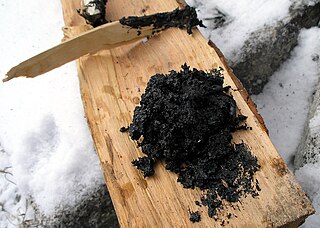 W
WBirch tar or birch pitch is a substance derived from the dry distillation of the bark of the birch tree.
 W
WBlu Tack is a reusable putty-like pressure-sensitive adhesive produced by Bostik, commonly used to attach lightweight objects to walls, doors or other dry surfaces. Traditionally blue, it is also available in other colours. Generic versions of the product are also available from other manufacturers. The spelling now used is without a hyphen.
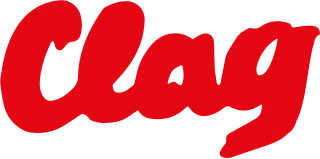 W
WClag is an Australian brand of glue made by Bostik.
 W
WConstruction adhesive is a general-purpose adhesive used for attaching drywall, tile, molding, and fixtures to walls, ceilings, and floors. It is most commonly available in tubes intended for use with a caulking gun.
 W
WCyanoacrylates are a family of strong fast-acting adhesives with industrial, medical, and household uses. They are derived from ethyl cyanoacrylate and related esters. The cyanoacrylate group in the monomer rapidly polymerize in the presence of water to form long, strong chains. They have some minor toxicity.
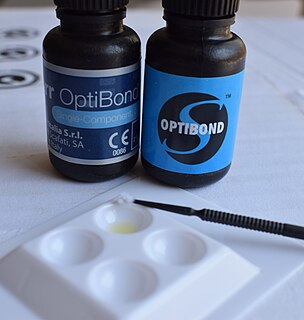 W
WAlso known as a "bonderizer" bonding agents are resin materials used to make a dental composite filling material adhere to both dentin and enamel.
 W
WDiachylon, also rendered diachylum or diaculum, was originally a kind of medicament made of the juices of several plants, but now commonly the name for lead-plaster, emplastrum plumbi—a plaster made of lead oxide boiled together with olive oil and water. It is applied to sheets of linen, and works as an adhesive plaster when heated.
 W
WDonkey-hide gelatin or ass-hide glue is gelatin obtained from the skin of the donkey by soaking and stewing. It is used as an ingredient in the traditional medicine of China, where it is called ejiao.
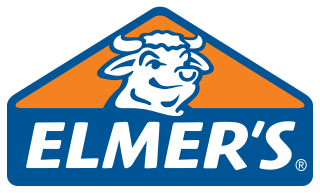 W
WElmer's Products is an American-based company that has a line of adhesive, craft, home repair, and office supply products. It is best known as the manufacturer of Elmer's Glue-All, a popular PVA-based synthetic glue, in addition to other brands including Krazy Glue, ProBond adhesives, and X-Acto cutting tools.
 W
WEpoxy refers to any of the basic components or cured end products of epoxy resins, as well as a colloquial name for the epoxide functional group. Epoxy resins, also known as polyepoxides, are a class of reactive prepolymers and polymers which contain epoxide groups.
 W
WFevicol is a brand of adhesives owned by the Indian company Pidilite Industries Limited.
 W
WFibrin glue is a surgical formulation used to create a fibrin clot for hemostasis or wound healing. It contains separately packaged human fibrinogen and human thrombin.
 W
WFuran resin refers to polymers produced from various furan compounds, of which the most common starting materials are furfuryl alcohol and furfural. In the resin and in the cured polyfurfurol, the furan rings are not connected by conjugation. The resins are generally used as binders for sand castings. The furan monomer is typically converted to a free-flowing resin with mild acid catalysis. Curing is achieved using strong acid.
 W
WGlue sticks are solid adhesives in twist or push-up tubes. Users can apply glue by holding the open tube to keep their fingers clean and rubbing the exposed stick against a surface.
 W
WGorilla Glue is an American brand of polyurethane adhesives. They are known for their original Gorilla Glue, which was first sold in 1994. The company has since branched out to make a line of similar products, including tapes, epoxies, and other adhesives. The company is based in Sharonville, Ohio.
 W
WHMG Heat and Waterproof Adhesive is a brand of cellulose nitrate adhesive manufactured by H Marcel Guest Ltd. It is one of the most popular cellulose nitrate adhesives used in conservation and restoration work, and is used on materials such as metal, wood, glass, and pottery. It is sometimes referred to as "the blue tube", in contrast to "the purple tube", the acrylic B72 Restoration Adhesive also manufactured by the company.
 W
WHot melt adhesive (HMA), also known as hot glue, is a form of thermoplastic adhesive that is commonly sold as solid cylindrical sticks of various diameters designed to be applied using a hot glue gun. The gun uses a continuous-duty heating element to melt the plastic glue, which the user pushes through the gun either with a mechanical trigger mechanism on the gun, or with direct finger pressure. The glue squeezed out of the heated nozzle is initially hot enough to burn and even blister skin. The glue is sticky when hot, and solidifies in a few seconds to one minute. Hot melt adhesives can also be applied by dipping or spraying, and are popular with hobbyists and crafters both for affixing and as an inexpensive alternative to resin casting.
 W
WImpact glue, contact glue or neoprene glue, is a type of glue, used mainly to glue plastic foams, laminates, metal panels, etc. It also allows the mounting of supports of different types. Contact-type adhesives do not exclusively designate neoprene adhesives, but also all other adhesives characterized by high instant adhesion.
 W
WIsobutyl cyanoacrylate is an isomer of butyl cyanoacrylate. It is used in medical procedures either to close incisions and lacerations without the use of sutures, or as an adjunct to strengthen the suturing. This use is possible because it is a bactericidal liquid monomer which, in the presence of small amounts of moisture, rapidly polymerizes to form a strong adhesive.
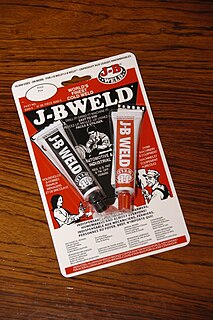 W
WThe J-B Weld Company is an international company that produces epoxy products. The home office is based in Sulphur Springs, Texas. J-B Weld is the name of their flagship product: a specialized, high-temperature epoxy adhesive for use in bonding materials together. The company has run advertisements showing engine block repair with J-B Weld.
 W
WCyanoacrylates are a family of strong fast-acting adhesives with industrial, medical, and household uses. They are derived from ethyl cyanoacrylate and related esters. The cyanoacrylate group in the monomer rapidly polymerize in the presence of water to form long, strong chains. They have some minor toxicity.
 W
WWheat paste is a gel or liquid adhesive made from wheat flour or starch and water. It has been used since antiquity for various arts and crafts such as book binding, découpage, collage, papier-mâché, and adhering paper posters and notices to walls.
 W
WLoctite is a German brand of adhesives, sealants, surface treatments, and other industrial chemicals that include acrylic, anaerobic, cyanoacrylate, epoxy, hot melt, silicone, urethane and UV/light curing technologies. Loctite products are sold globally and are used in a variety of industrial and hobbyist applications.
 W
WMucilage is a thick, gluey substance produced by nearly all plants and some microorganisms. These microorganisms include protists which use it for their locomotion. The direction of their movement is always opposite to that of the secretion of mucilage. It is a polar glycoprotein and an exopolysaccharide. Mucilage in plants plays a role in the storage of water and food, seed germination, and thickening membranes. Cacti and flax seeds are especially rich sources of mucilage.
 W
WRubber is also called India rubber, latex, Amazonian rubber, caucho or caoutchouc, as initially produced, consists of polymers of the organic compound isoprene, with minor impurities of other organic compounds, plus water. Thailand and Indonesia are two of the leading rubber producers. Types of polyisoprene that are used as natural rubbers are classified as elastomers.
 W
WParaloid B-72 or B-72 is a thermoplastic resin that was created by Rohm and Haas for use as a surface coating and as a vehicle for flexographic ink. Today B-72 is commonly being used as an adhesive by conservator-restorers, specifically in the conservation and restoration of ceramic objects, glass objects, the preparation of fossils, the hardening of piano hammers, and can also be used for labeling museum objects.
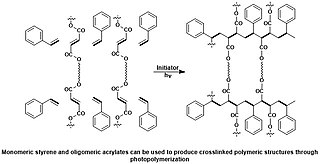 W
WA photopolymer or light-activated resin is a polymer that changes its properties when exposed to light, often in the ultraviolet or visible region of the electromagnetic spectrum. These changes are often manifested structurally, for example hardening of the material occurs as a result of cross-linking when exposed to light. An example is shown below depicting a mixture of monomers, oligomers, and photoinitiators that conform into a hardened polymeric material through a process called curing.
 W
WPidilite Industries Limited is an Indian adhesives manufacturing company. It also sells art material, construction chemicals and other industrial chemicals. It manufactures products which can be segmented into consumer products: art materials & stationary, publications, food & fabric care, car products and adhesives & sealants, specialty industrial products: industrial adhesives, industrial pigments, industrial & textile resins and leather chemicals.
 W
WPolybenzoxazines, also called benzoxazine resins, are cured polymerization products derived from benzoxazine monomers.
 W
WPolyurethane is a polymer composed of organic units joined by carbamate (urethane) links. While most polyurethanes are thermosetting polymers that do not melt when heated, thermoplastic polyurethanes are also available.
 W
WPolyvinyl acetate (PVA, PVAc, poly(ethenyl ethanoate)), commonly known as wood glue, white glue, carpenter's glue, school glue, or Elmer's glue in the US, is a widely available adhesive used for porous materials like wood, paper, and cloth. An aliphatic rubbery synthetic polymer with the formula (C4H6O2)n, it belongs to the polyvinyl ester family, with the general formula -[RCOOCHCH2]-. It is a type of thermoplastic.
 W
WPressure-sensitive adhesive is a type of non reactive adhesive which forms a bond when pressure is applied to bond the adhesive with a surface. No solvent, water, or heat is needed to activate the adhesive. It is used in pressure-sensitive tapes, labels, glue dots, note pads, automobile trim, and a wide variety of other products.
 W
WPritt is a brand of adhesives, tapes, KidsArt, correction, and fixing products designed and marketed by Henkel. Originally called "Pretty Sticky", this was later condensed to Pritt Stick after the inventor's young child mispronounced its name. Pritt invented the world's first glue stick, also known as the Pritt Stick, which is a solid adhesive in a twistable casing.
 W
WRabbit-skin glue is a sizing that also acts as an adhesive. It is essentially refined rabbit collagen, and was originally used as an ingredient in traditional gesso.
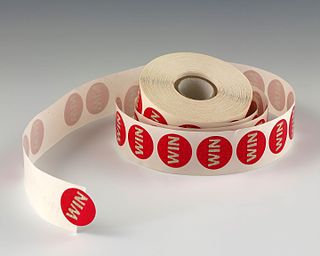 W
WA release liner is a paper or plastic-based film sheet used to prevent a sticky surface from prematurely adhering. It is coated on one or both sides with a release agent, which provides a release effect against any type of a sticky material such as an adhesive or a mastic. Release liners are available in different colors, with or without printing under the low surface energy coating or on the backside of the liner. Release is separation of the liner from a sticky material; liner is the carrier for the release agent.
 W
WResorcinol glue, also known as resorcinol-formaldehyde, is an adhesive combination of resin and hardener that withstands long-term water immersion and has high resistance to ultraviolet light. The adhesive, introduced in 1943, has been popular in aircraft and boat construction.
 W
WRice glue is a gel or liquid adhesive made of a smooth mush of well-cooked white rice, diluted to the desired thickness with water. It has been used since antiquity for various arts and crafts; for instance, it is a woodworking and paper glue. When dried, it is transparent. Rice glue is notable for containing no acids which can degrade the materials it holds together.
 W
WRubber cement is an adhesive made from elastic polymers mixed in a solvent such as acetone, hexane, heptane or toluene to keep it fluid enough to be used. This makes it part of the class of drying adhesives: as the solvents quickly evaporate, the rubber solidifies, forming a strong yet flexible bond.
 W
WA self-adhesive stamp is a postage stamp with a pressure-sensitive adhesive that does not require moistening in order to adhere to paper. They are usually issued on a removable backing paper.
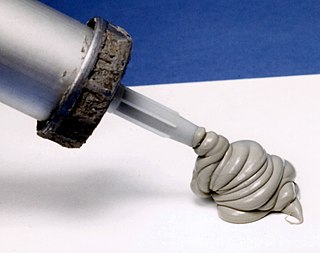 W
WA silicone or polysiloxane are polymers made up of siloxane (−R2Si−O−SiR2−, where R = organic group). They are typically colorless, oils or rubber-like substances. Silicones are used in sealants, adhesives, lubricants, medicine, cooking utensils, and thermal and electrical insulation. Some common forms include silicone oil, silicone grease, silicone rubber, silicone resin, and silicone caulk.
 W
WIn table tennis, speed glue is a glue that is used to re-fix the rubber surfaces to the racket or paddle. Speed glue is usually applied around 30 minutes before a match starts. The use of speed glue has been found to increase the elasticity of the racket, which adds speed and spin to the ball.
 W
WSpirit gum is an adhesive, made mostly of SD Alcohol 35-A and resin originally consisting of mastix, used primarily for affixing costume prosthetics such as wigs, merkins, or false facial hair. It has been manufactured since at least the 1870s, and has long been a standard tool in theatrical performances where prosthetic makeup or affixed costuming is used. It was mentioned in the earliest known published theatre makeup manual: "How to make-up; a practical guide for amateurs by Haresfoot and Rouge" in 1877. At the end of the nineteenth century, spirit gum could be procured by performers at theatrical wig makers and it was removed with alcohol, cocoa butter or vaseline.
A sticky mat, also called a tacky mat or cleanroom mat, is a mat with an adhesive surface that is placed at the entrances or exits to certain workplaces to remove contaminants from the bottoms of footwear and wheeled carts such as hand trucks. They are an example of an engineering control within the hierarchy of hazard controls.
 W
WThermal paste is a thermally conductive chemical compound, which is commonly used as an interface between heat sinks and heat sources such as high-power semiconductor devices. The main role of thermal paste is to eliminate air gaps or spaces from the interface area in order to maximize heat transfer and dissipation. Thermal paste is an example of a thermal interface material.
 W
WThread-locking fluid or threadlocker is a thin, single-component adhesive, applied to the threads of fasteners such as screws and bolts to prevent loosening, leakage, and corrosion.
 W
WUHU GmbH & Co. KG is a German manufacturer of adhesive products, based in Bühl, Germany. Its company slogan is "Don't say glue, say UHU!". The company logo is yellow with black lettering and in many markets it includes the German phrase: "German: Der Alleskleber".
 W
WWallpaper adhesive or wallpaper paste is a specific adhesive, based on modified starch or methylcellulose, used to fix wallpaper to walls.
 W
WWheat paste is a gel or liquid adhesive made from wheat flour or starch and water. It has been used since antiquity for various arts and crafts such as book binding, découpage, collage, papier-mâché, and adhering paper posters and notices to walls.
 W
W